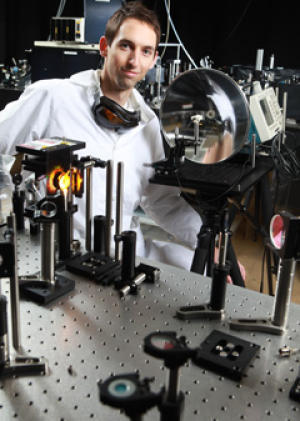Benjamin Clough has developed a novel method for eavesdropping on terahertz information hidden in invisible plasma acoustic bursts. The doctoral student at Rensselaer Polytechnic Institute has demonstrated a promising technique that employs sound waves to boost the distance from which researchers can use powerful terahertz technology to remotely detect hidden explosives, chemicals, and other dangerous materials.
Clough, a student in the Department of Electrical, Computer, and Systems Engineering at Rensselaer, is one of three finalists for the 2011 $30,000 Lemelson-MIT Rensselaer Student Prize. Clough's project is titled "Terahertz Enhanced Acoustics," and his faculty adviser is Xi-Cheng Zhang, the J. Erik Jonsson Professor of Science at Rensselaer and director of the university's Center for Terahertz Research.
The Rensselaer Center for Terahertz Research is one of the most active groups worldwide to apply terahertz wave technology for security and defense applications. Sensors using terahertz waves can penetrate packaging materials or clothing and identify the unique terahertz "fingerprints" of many hidden materials. Terahertz waves occupy a large segment of the electromagnetic spectrum between the infrared and microwave bands. Unlike X-rays and microwaves, terahertz radiation is very low energy and poses no known health threat to humans.
A key practical limitation of terahertz technology, however, is that it only works over short distances. Naturally occurring moisture in air absorbs terahertz waves, weakening the signal and sensing capabilities. This distance limitation is not ideal for applications in bomb or hazardous material detection, where the human operator wants to be as far away as possible from the potential threat.
Clough's patent-pending solution to this problem is a new method for using sound waves to remotely "listen" to terahertz signals from a distance. Focusing two laser beams into air creates small bursts of plasma, which in turn create terahertz pulses. Another pair of lasers is aimed near the target of interest to create a second plasma for detecting the terahertz pulses after they have interacted with the material. This detection plasma produces acoustic waves as it ionizes the air. Clough discovered that by using a sensitive microphone to "listen" to the plasma, he could detect terahertz wave information embedded in these sound waves. This audio information can then be converted into digital data and instantly checked against a library of known terahertz fingerprints, to determine the chemical composition of the mystery material.
So far, Clough has successfully demonstrated the ability to use acoustics to identify the terahertz fingerprints from several meters away. He has separately demonstrated plasma acoustic detection from 11 meters, limited only by available lab space. Along with the increased distance from the potentially hazardous material, an additional advantage is that his system does not require a direct line of sight to collect signals, as the microphone can still capture the audio information. Potential applications of Clough's invention, which circumvents the fundamental limitations of remote terahertz spectroscopy, include environmental monitoring of atmospheric conditions, monitoring smokestack emissions, inspecting suspicious packages, or even detecting land mines -- all from a safe distance.
Clough has presented his findings at several international conferences, and the details of his work have been published in Optics Letters and Physical Review E. His new method for terahertz sensing has created the possibility to obtain terahertz spectroscopic information from a distance, bypassing a key limitation of high terahertz absorption by water vapor in air.
A National Science Foundation Integrative Graduate Education and Research Traineeship (IGERT) fellow, Clough is deeply committed to his research activities.

Benjamin Clough. (Credit: Rensselaer/Kris Qua)
From:http://www.sciencedaily.com/releases/2011/02/110228130839.htm